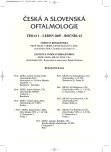Contrast Sensitivity and Fluorescein Angiography in Evaluating the Ocular Changes in the Relation to the Diabetes Mellitus type I Compensation in Young Adult Patients
Authors:
J. Krásný 1,2,5; I. Cihelková 1; Z. Domínek 1; P. Souček 1,2; L. Trešlová 3,5; J. Lebl 4,5; M. Anděl 3,5
Authors‘ workplace:
Oční klinika FN Královské Vinohrady a 3. LF UK, Praha
přednosta prof. MUDr. P. Kuchynka, CSc.
1; Katedra oftalmologie Institutu postgraduálního vzdělávání
ve zdravotnictví, Praha
vedoucí prof. MUDr. P. Kuchynka, CSc.
2; 2. interní klinika FN Královské Vinohrady a 3. LF UK, Praha
přednosta prof. MUDr. M. Anděl, CSc.
3; Klinika dětí a dorostu FN Královské Vinohrady a 3. LF UK, Praha
přednosta prof. MUDr. J. Lebl, CSc
4; Centrum pro výzkum diabetu, metabolismu a výživy
3. LF UK, Praha
vedoucí prof. MUDr. M. Anděl, CSc.
5
Published in:
Čes. a slov. Oftal., 63, 2007, No. 1, p. 17-27
Overview
The authors performed simultaneous contrast sensitivity examination (CS) and fluorescein angiography (FAG) in 42 patients older than 18 years of age; in 65 % of them the duration of the diabetes mellitus type I (T1DM) was longer than 10 years. In these 27 patients, the diagnosis of non-prolipherative diabetic retinopathy (NPDR) was established by means of FAG in 44 %, in contrast to only 19 % by means of the direct ophthalmoscopy solely. The other findings (56 %) were corresponding with diabetic preretinopathy (DpR) due to rare micro-aneurysms (establishes by means of FAG), and changes of the macular structure and pronounced dilation and tortuosity of the capillaries (by means of direct ophthalmoscopy). Out of the other 15 patients with T1DM duration of less than 10 years, the NPDR was established in 3 patients, and DpR confirmed in other 7 patients from the group. The authors compared the decrease in every single space frequency marked on the CS curvature for 31 eyes with NPDR and 39 eyes with DpR with the normal findings in patients without T1DM established in previous studies. Comparing NPDR with the norm, the authors found important and fundamental pathological defect of the CS (p = 0.0058). DpR comparing with the norm showed significant defect of the CS (p = 0.0197). Comparing NPDR and DpR, the difference was found in more noticeable pathological defect of the CS (p = 0.0228). The compensation of the metabolic state was evaluated from average yearlong values of the glycolated hemoglobin (Hb1Ac) in the last 10 years of the T1DM duration by means of DCCT method. The group of followed- up patients consisted of pairs of matched patients with NPDR and DpR of the same gender, time of beginning and duration of the metabolic disease. In the NPDR patients, the compensation was not good in 72 % of this period, whereas in DpR patients the satisfactory compensation lasted for 53 % of this period. During the follow up period, in NPDR the average Hb1Ac level was 8.49 ± 0.88 %, and in DpR this Hb1Ac value was 7.61 ±0.28 %, with statistically significant difference (p = 0.0033). During the period, in DpR patients no serious complication was marked, in the NPDR group, the incipient diabetic nephropathy twice and slight diabetic neuropathy were noticed. The occasional pathological values of the microalbuminuria were not possible to correlate with beginning of the NPDR.
Conclusion:
The contrast sensitivity (CS) represents in the differential diagnosis of the NPDR and DpR a screening examination method. To specify the NPDR, the FAG is suitable and for both clinical entities specifies the extent of foveolar and perifoveolar involvement. Only the many years lasting follow up of Hb1Ac values documents the importance of long-term T1DM compensation in the prevention of pathological ocular changes development.
Key words:
contrast sensitivity (CS), fluorescein angiography (FAG), diabetic pre-retinopathy (DpR), non-prolipherative diabetic retinopathy (NPDR), glycolated hemoglobin (Hb1Ac)
Labels
OphthalmologyArticle was published in
Czech and Slovak Ophthalmology

2007 Issue 1
Most read in this issue
- If you Say “Better than with the Wire into the Eye...” a Case Report
- Refractive Lensectomy – Longterm Results
- Intraocular Lens Power Calculation in the Triple Procedure
- Wegener’s Granulomatosis – a Case Report
